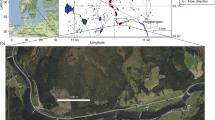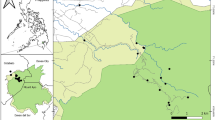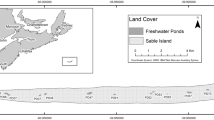Abstract
Freshwater invasive or alien species (IAS) can have a major impact on benthic macroinvertebrate assemblage structure and diversity. This has implications for accurate biological monitoring, the assessment of the ecological quality status of rivers and achievement of Water Framework Directive (WFD) objectives. Although IAS constitutes a major biological pressure to WFD objectives, current approaches to ecological status assessment tend to ignore their presence. This problem is compounded as biotic indices such as the Biological Monitoring Working Party (BMWP) score do not distinguish between native and IAS, when IAS tend to be more tolerant of organic pollution than the natives they replace. Biocontamination is the presence of an IAS in a system, and we tested a new method of biocontamination assessment, designed to be used alongside current routine water quality monitoring techniques, by applying it to biological monitoring data from the river monitoring programme of a small Island, The Isle of Man. Although 54% of monitoring sites exhibited no biocontamination, 19% showed low or moderate biocontamination and 27% high or severe biocontamination. Richness contamination was low (only two contaminated families being recorded), but abundance contamination was high in some sites (87% of individuals being IAS). Sites with a greater relative abundance of IAS individuals exhibited lower BMWP water quality. Within invaded sites BMWP monitoring was not responsive to changing chemical water quality, whereas within uninvaded sites it was. In invaded sites, the relative abundance of IAS increased as ammonia and BOD5 increased. Our study shows current monitoring approaches mask the presence of AIS within assemblages, with some highly biocontaminated sites registering high BMWP biological quality. This new index represents a simple way to integrate the IAS biological pressure into established WFD monitoring programmes, to produce more comprehensive estimates of ecological quality status than are currently being realised.



Similar content being viewed by others

References
AQEM Consortium, 2002. Manual for the application of the AQEM system. A Comprehensive Method to Assess European Streams using Benthic Macroinvertebrates, developed for the Purpose of the Water Framework Directive. Version 1.0, February 2002 (available at www.aqem.de).
Arbačiauskas, K., V. Semenchenko, M. Grabowski, R. S. E. W. Leuven, M. Paunovic, M. O. Son, B. Csanyi, S. Gumuliauskaite, A. Konopacka, S. Nehring, G. van der Velde, V. Vezhnovetz & V. E. Panov, 2008. Assessment of biocontamination of benthic macroinvertebrate communities in European inland waterways. Aquatic Invasions 3: 211–230.
Armitage, P. D., D. Moss, J. F. Wright & M. T. Furse, 1983. The performance of a new biological quality score system based on macroinvertebrates over a wide range of unpolluted running water sites. Water Research 17: 333–347.
Biological Monitoring Working Party, 1978. Final Report: Assessment and Presentation of the Biological Quality of Rivers in Great Britain. December 1978. Water Data Unit, Department of the Environment, London.
Cardoso, A. C. & G. Free, 2008. Incorporating invasive alien species into ecological assessment in the context of the Water Framework Directive. Aquatic Invasions 3: 361–366.
Cohen, A. N. & J. T. Carlton, 1997. Transoceanic transport mechanisms: introduction of the Chinese mitten crab, Eriocheir sinensis, to California. Pacific Science 51: 1–11.
Colautti, R. I. & H. J. MacIsaac, 2004. A neutral terminology to define ‘invasive’ species. Diversity and Distributions 10: 135–141.
Conlan, K. E., 1994. Amphipod crustaceans and environmental disturbance: a review. Journal of Natural History 28: 519–554.
Crawford, L., W. E. Yeomans & C. E. Adams, 2006. The impact of introduced signal crayfish Pacifastacus leniusculus on stream invertebrate communities. Aquatic Conservation: Marine and Freshwater Ecosystems 16: 611–621.
Dick, J. T. A., 2008. Role of behaviour in biological invasions and species distributions; lessons from interactions between the invasive Gammarus pulex and the native G. duebeni (Crustacea: Amphipoda). Contributions to Zoology 77: 91–98.
Dick, J. T. A. & D. Platvoet, 2000. Invading predatory crustacean Dikerogammarus villosus eliminates both native and exotic species. Proceedings of the Royal Society of London Series B, Biological Sciences 267: 977–983.
Dick, J. T. A., N. Nelson & J. D. D. Bishop, 1997. Introduction experiments with Gammarus spp. (Crustacea: Amphipoda) in the Isle of Man (British Isles), 1949–1995. Journal of Zoology 242: 209–216.
Ding, J., R. N. Mack, P. Lu, M. Ren & H. Huang, 2008. China’s booming economy is sparking and accelerating biological invasions. Bioscience 58: 317–324.
European Commission, 2000. Directive 2000/60/EC of the European Parliament and of the council of 23 October 2000 establishing a framework for community action in the field of water policy. Official Journal of the European Communities L 327: 1–72.
Hynes, H. B. N., 1950. Preliminary Report on Work on Freshwater Species of Gammarus in the Isle of Man—Annual Report for 1949 (No. 62) of the Marine Biological Station, Port Erin, Isle of Man.
Kelly, D. W., J. T. A. Dick & W. I. Montgomery, 2002. Predation on mayfly nymphs, Baetis rhodani, by native and introduced Gammarus: direct effects and the facilitation of predation by salmonids. Freshwater Biology 47: 1257–1268.
Kelly, D. W., J. T. A. Dick, W. I. Montgomery & C. MacNeil, 2003. Differences in composition of macroinvertebrate communities with invasive and native Gammarus spp. (Crustacea: Amphipoda). Freshwater Biology 48: 306–315.
Kelly, D. W., R. J. E. Bailey, C. MacNeil, J. T. A. Dick & R. A. McDonald, 2006. Invasion by the amphipod Gammarus pulex alters community composition of native freshwater macroinvertebrates. Diversity and Distributions 12: 525–534.
Krisp, H. & G. Maier, 2005. Consumption of macroinvertebrates by invasive and native gammarids: a comparison. Journal of Limnology 64: 55–59.
Leuven, R. S. E. W., G. van der Velde, I. Baijens, J. Snijders, C. van der Zwart, H. J. R. Lenders & A. bij de Vaate, 2009. The river Rhine: a global highway for dispersal of aquatic invasive species. Biological Invasions 11: 1989–2008.
MacNeil, C., 2006. River Quality 2005. Government Laboratory, Department of Local Government and Environment, Isle of Man Government (available at www.gov.im/dlge/enviro/govlabs).
MacNeil, C. & M. Briffa, 2009. Replacement of a native freshwater macroinvertebrate species by an invader; implications for biological water quality monitoring. Hydrobiologia 635: 321–327.
MacNeil, C., J. T. A. Dick & R. W. Elwood, 1999. The dynamics of predation on Gammarus spp. (Crustacea: Amphipoda). Biological Reviews of the Cambridge Philosophical Society 74: 375–395.
MacNeil, C., J. T. A. Dick & R. W. Elwood, 2000. Differential physico-chemical tolerances of amphipod species revealed by field transplantations. Oecologia 124: 1–7.
MacNeil, C., W. I. Montgomery, J. T. A. Dick & R. W. Elwood, 2001. Factors influencing the distribution of the native and introduced Gammarus species in Irish river systems. Archiv für Hydrobiologie 151: 353–368.
MacNeil, C., J. Prenter, M. Briffa, N. J. Fielding, J. T. A. Dick, G. E. Riddell, M. J. Hatcher & A. M. Dunn, 2004. The replacement of a native freshwater amphipod by an invader: roles for environmental degradation and intraguild predation. Canadian Journal of Fisheries and Aquatic Sciences 61: 1627–1635.
MacNeil, C., D. Platvoet & J. T. A. Dick, 2008. Potential roles for differential body size and microhabitat complexity in mediating biotic interactions within invasive freshwater amphipod assemblages. Archiv für Hydrobiologie 172(3): 175–182.
MacNeil, C., J. T. A. Dick, F. R. Gell, R. Selman, P. Lenartowicz & H. B. N. Hynes, 2009. A long-term study (1949–2005) of experimental introductions to an Island; freshwater amphipods (Crustacea) in the Isle of Man (British Isles). Diversity and Distributions 15: 232–241.
Pinkster, S., M. Scheepmaker, D. Platvoet & N. Broodbakker, 1992. Drastic changes in the amphipod fauna (Crustacea) of Dutch inland waters during the last 25 years. Bijdragen tot de Dierkunde 61: 193–204.
Piscart, C., J. T. A. Dick, D. McCrisken & C. MacNeil, 2009. Environmental mediation of intraguild predation between the freshwater invader Gammarus pulex and the native G. duebeni celticus. Biological Invasions 11: 2141–2145.
Ricciardi, A., 2001. Facilitative interactions among aquatic invaders: is an “invasional meltdown” occurring in the Great Lakes? Canadian Journal of Fisheries and Aquatic Sciences 58: 2513–2525.
Ricciardi, A. & J. Cohen, 2007. The invasiveness of an introduced species does not predict its impact. Biological Invasions 9: 309–315.
Ricciardi, A., R. J. Neves & J. B. Rasmussen, 1998. Impending extinctions of North American freshwater mussels (Unionidae) following the zebra mussel (Dreissena polymorpha) invasion. Journal of Animal Ecology 67: 613–619.
Rosenberg, D. M. & V. H. Resh (eds), 1993. Freshwater Biomonitoring and Benthic Macroinvertebrates. Chapman & Hall, New York.
Sala, O. E., F. S. Chapin, J. J. Armesto, E. Berlow, J. Bloomfield, R. Dirzo, E. Huber-Sanwald, L. F. Huenneke, R. B. Jackson, A. Kinzig, R. Leemans, D. M. Lodge, H. A. Mooney, M. Oesterheld, N. L. Poff, M. T. Sykes, B. H. Walker, M. Walker & D. H. Wall, 2000. Global biodiversity scenarios for the year 2100. Science 287: 1770–1774.
Solheim, A. L. & R. D. Gulati, 2008. Preface: ‘Quantitaive ecological responses for the Water Framework Directive related to eutrophication and acidification of European lakes’. Aquatic Ecology 42: 293–305.
Styles, P. D., 2001. River Quality 2000. Government Laboratory, Department of Local Government and Environment, Isle of Man Government (available at www.gov.im/dlge/enviro/govlabs).
Sykes, J. M., A. M. J. Lane & D. G. George, 1999. The United Kingdom environmental change network: protocols for standard measurements at freshwater sites. Centre for Ecology and Hydrology, Natural Environment Research Council, UK
Van Riel, M. C., G. van der Velde, S. Rajagopal, S. Marguillier, F. Dehairs & A. B. de Vaate, 2006. Trophic relationships in the Rhine food web during invasion and after establishment of the Ponto-Caspian invader Dikerogammarus villosus. Hydrobiologia 565: 39–58.
Veldhuizen, T. C. & S. Stanish, 1999. Overview of the History, Distribution and Impact of the Chinese Mitten Crab (Eriocheir sinensis). California Department of Water Resources, Sacramento.
Walley, W. J. & H. A. Hawkes, 1996. A computer-based reappraisal of the biological monitoring working party scores using data from the 1990 river quality survey of England and Wales. Water Research 9: 2086–2094.
Wright, J. F., D. Moss, P. D. Armitage & M. T. Furse, 1984. A preliminary classification of running-water sites in Great Britain based on macro-invertebrate species and the prediction of community type using environmental data. Freshwater Biology 14: 221–256.
Wright, J. F., D. W. Sutcliffe & M. T. Furse, 2000. Assessing the Biological Quality of Freshwaters—RIVPACS and Other Techniques. Freshwater Biological Association, Ambleside.
Acknowledgements
The authors thank James Singleton, Neil Longwith and Elizabeth Green for processing chemical samples. They also thank Peeter Nõges and two anonymous referees whose comments greatly improved this manuscript.
Author information
Authors and Affiliations
Corresponding author
Additional information
Handling editor: P. Nõges
Rights and permissions
About this article
Cite this article
MacNeil, C., Briffa, M., Leuven, R.S.E.W. et al. An appraisal of a biocontamination assessment method for freshwater macroinvertebrate assemblages; a practical way to measure a significant biological pressure?. Hydrobiologia 638, 151–159 (2010). https://doi.org/10.1007/s10750-009-0037-x
Received:
Revised:
Accepted:
Published:
Issue Date:
DOI: https://doi.org/10.1007/s10750-009-0037-x



